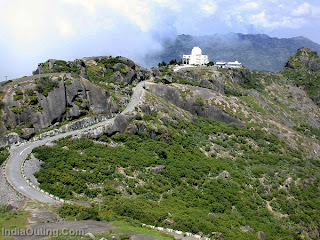Mount Abu is the highest peak in the Aravalli Range of Rajasthan state in western India. It is located in Sirohi district. Mount Abu is 58 km from Palanpur (Gujarat). The
mountain forms a distinct rocky plateau 22 km long by 9 km wide. The highest peak on the mountain is Guru Shikhar, at 1,722 metres (5,650 ft) above sea level. It is referred to as 'an oasis in the desert', as its heights are home to rivers, lakes, waterfalls and evergreen forests. The ancient name of Mount Abu is "Arbudaanchal"
History :-
The Arbuda Mountains (Mount Abu) region is said to be original abode of the famous Gurjaras.The association of the Gurjars with the mountain is noticed in many inscriptions and epigraphs including Tilakamanjari of Dhanpala. These Gurjars (Gujars or Gujjars) migrated from Arbuda mountain region and as early as sixth century A.D, they set up one or more principalities in Rajasthan and Gujarat. Almost all or a larger part of Rajasthan and Gujarat had been known as Gurjaratra (country ruled or protected by the Gurjars) or Gurjarabhumi(land of the Gurjars) for centuries prior to Mughal period.
The conquest of Mount Abu in 1311 by Rao Lumba of Deora-Chauhan dynasty brought to an end the reign of the Parmars and also marked the decline of Mount Abu. He shifted the capital city to Chandravati in the plains. After the destruction of Chandravati in 1405, Rao Shasmal made Sirohi his headquarters.Later it was leased by the British government from the then Maharaja of Sirohi for use as the headquarter of the resident to Rajputana (another name for Rajasthan).
Mythology :-
In the Puranas, the region has been referred to as Arbudaranya, ("forest of Arbhuda") and 'Abu' is a dimunitive of this ancient name. It is believed that sage Vasishtha retired to the southern spur at Mount Abu following his differences with sage Vishvamitra. There is another mythology according to which a serpant named "Arbuda" who saved the life of Nandi - Lord Shiva's bull. The incident happened on the mountain which is currently known as mount Abu and so the mountain is named "Arbudaranya" after this incident which gradually became Abu.
Tourists Attractions :-
The town of Mount Abu, the only hill station in Rajasthan, is located at an elevation of 1,220 m (4,003 ft). It has been a popular retreat from the heat of Rajasthan and neighbouring Gujarat for centuries. The Mount Abu Wildlife Sanctuary was established in 1960 and covers 290 km² of the mountain.
The mountain is also home to several Hindu temples, including the Adhar Devi Temple, carved out of solid rock; the Shri Raghunathji Temple; and a shrine and temple to Dattatreya built atop the Guru Shikhar peak and a number of Jain temples including Dilwara, a complex of temples carved of white marble that was built between the 11th and 13th centuries AD. The oldest of these is the Vimal Vasahi temple, built in 1021 AD by Vimal Shah and dedicated to the first of the Jain Tirthankaras and they include the Achaleswar Mahadev Temple (1412) and the Kantinath Temple (1513). It is also the location of "Madhuban", the headquarters of the Brahma Kumaris World Spiritual University.
The Achalgarh fort, built in the 14th century by Rana Kumbha of Mewar is nearby and at its center is the popular visitor attraction of the Nakki Lake. There is the Toad Rock on a hill near the lake.
The Durga temple, Ambika Mata Temple lies in a cleft of rock in Jagat, just outside of Mount Abu.
Climate :-
Summer Summer season prevails from mid of April to mid of June when average Maximum temperature remains around 36 °C. Therefore it will be better if you bring light cotton clothes. These clothes are fit for the summers of Mount Abu.
Monsoon Due to its relief and geographical conditions, it rains well in Mount Abu during the monsoons. During the rainy season even the temperature falls down. Normal summer clothing will do. It is wiser to carry an umbrella in order to avoid being caught at the wrong side of monsoon.
Winter Winters are cool in Mount Abu, with mercury hovering around 16 °C to 22 °C. Nights are really chilly and average night temperature is around 4 to 12 °C. Nevertheless, there are instances when the temperature has dipped to as low as −2 to −3 °C. Heavy winter clothing is preferable. You can include long coats and outsiders in your luggage. In daytime, light pullovers are sufficient.
Transportation :-
The nearest railway station is at Abu Road, in the lowlands 27 km southeast of Mount Abu town. The station is on the main Indian Railways line between Delhi,Palanpur and Ahmedabad.Its is very well connected with daily travels bus service from Ahmedabad and other big cities of Gujarat. It has regular trains for Jaipur, Jodhpur, Udaipur, Ajmer, Indore, Agra, Bhopal, Gwalior, Jabalpur, Ujjain, Delhi, Mumbai, Calcutta, Chennai, Hyderabad, Bangalore, Ahmedabad, Pune and weekly trains from Trivandrum(Kochu Veli).


.jpg)




